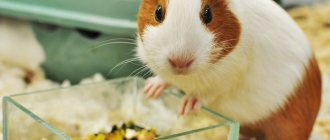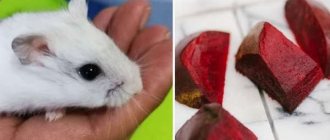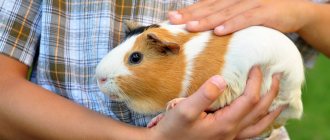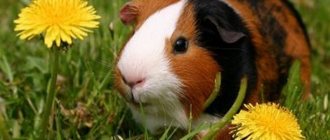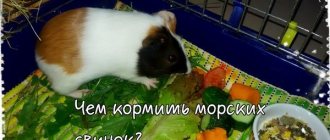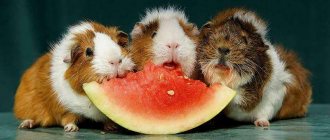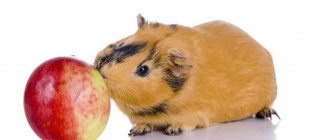Pet lovers try to diversify the diet of their pets. However, it happens that such care leads to sad consequences. Small pet rodents are at high risk of food poisoning. Often children try to feed them what they eat themselves. Adults also like to experiment - and not always successfully.
Potatoes are considered a popular and affordable food for animals. In raw and cooked form, it is widely used in animal husbandry. Many guinea pigs and hamsters love the vegetable in any form. But it is not suitable for everyone due to the physiological characteristics of the body.
Final Recommendations
The final decision on whether to include potatoes in a rodent’s diet is made by its owner. You cannot feed your animal green or sprouted tubers. Raw potatoes are first given in small quantities. When the pet eats a piece, the owner will need to monitor his reaction. If the animal’s health does not worsen within a few days after taking it, then potatoes can be added to the menu. The amount of product consumed should not exceed 20% of the total food. It is recommended to mix potato chunks with other solid foods. Elderly individuals should be fed boiled vegetables, softened with a fork until pureed. Old guinea pigs' teeth are not suitable for raw tubers.
Guinea pigs can be fed almost any fruit and vegetable. Despite this, there are some restrictions. They mainly concern products containing large amounts of starch.
Results
In conclusion, I would like to say that not everything that your guinea pig eats will be good for it. Do not try exotic products on her. If you don’t know whether your guinea pig can eat this or that product, it’s better not to feed it. A rodent in captivity cannot distinguish between products that are not healthy for it and therefore will eat everything you offer. On forums you can often see messages that some owners' guinea pigs eat almost all the foods on the prohibited list. But do not experiment on your pet; give him only vegetables, grass, herbs and fruits growing in our country. Believe me, without oranges, tangerines, bananas, kiwis and other harmful fruits, they will survive and live a long and happy pig life, delighting you.
« Previous entry
Can guinea pigs eat potatoes?
It refers to products that contain starch. This should already alert knowledgeable owners. About 15-20% carbohydrates, there are proteins, fats and ash substances which total 2.5-5%. Vitamins C, B1, B2, B6, P, K. We can conclude that such food will be very healthy. But pets are allowed to consume only in small quantities. Before doing this, you can cut it into small pieces.
If the pig has never eaten it before, then you should start with the minimum dose. Cut one small piece and watch the reaction. In the future it will be possible to increase the portions. But do not exaggerate, it should be no more than 20-25% of the diet. Potatoes contain solanine, which negatively affects the pet’s entire immune system, thereby making it more vulnerable to disease.
Can guinea pigs eat raw potatoes? You can put it in the feeder along with other vegetables. The animal will be able not only to eat, but also to grind its teeth
But be careful with doses, remember the toxins described above
Boiled potatoes should definitely be given to aging pigs. In old age, there is no longer that activity and strength, teeth weaken, and the need for soft food appears. Therefore, potatoes will be a useful addition to the main diet.
Why should you not give your guinea pig raw potatoes?
The guinea pig has high immunity to various kinds of diseases. But due to their intense metabolism, they have no protection against digestive disorders. Liquid stool quickly dehydrates the body, so the owner of a guinea pig should not put off going to the veterinarian. If you do not treat the animal, the consequences can be fatal.
The cause of diarrhea is poor diet. Often, inexperienced pig owners add starchy vegetables, such as raw potatoes, to their diet. This is absolutely impossible to do. The mass of starch in potatoes ranges from 10 to 18%, depending on the variety. Raw starch is poorly absorbed in the animal’s body and creates favorable conditions for the proliferation of pathogenic microflora in the intestines.
Vegetable harm
Since potatoes contain quite a lot of starch, regular and excessive consumption of them raw can lead to digestive upset. Starch is almost not absorbed by the guinea pig's body, and this can lead to the proliferation of pathogenic microflora in the intestines, which will inevitably lead to negative consequences.
The most undesirable effects of your pet eating such food may be obesity and chronic diarrhea. Constant “indigestion” is a direct path to severe dehydration of the animal’s body, which sometimes even leads to death. And due to excess starch in the body, liver diseases such as hepatitis and cirrhosis develop, which can also end in failure. These problems are associated with an increase in the size of the gland due to the growth of adipose tissue.
Did you know? Guinea pigs grow teeth throughout their lives, so they constantly need to be ground down with solid food.
And sometimes, if stored improperly or if pesticides are used to process tubers, solanine accumulates in the vegetable, a toxic substance that can lead to diarrhea. To be sure that your pet will not suffer from eating raw potatoes, but will only benefit from it, you need to consider the rules for the safe consumption of this vegetable.
Potato damage
If there is a high content of solanine in tubers, there is a risk of intoxication of animals.
The severity of poisoning depends on the amount of potatoes eaten and on the physiological characteristics of the animals.
For guinea pigs
Veterinarians consider the large amount of starch to be the main disadvantage of potatoes.
If your pet has a healthy digestive system and feels good after complementary feeding, they include raw vegetables in their diet, in small quantities and infrequently.
If there is an excess, the following consequences arise:
- obesity;
- liver enlargement;
- chronic diarrhea;
- hepatitis.
For hamsters
It is strictly forbidden to give raw potatoes to Djungarian hamsters.
The digestive system of this rodent is particularly sensitive. A small amount of solanine in the product will cause intoxication.
Djungarian hamsters are recommended boiled potatoes in moderation in combination with other foods.
For livestock
The tops and tubers of the vegetable are used to feed farm animals.
A small amount of solanine is found in potato tops and new potatoes. Its content increases with prolonged and improper storage.
Tubers left in the sun for a long time pose a great danger to livestock. Animals that graze in these fields after harvesting potatoes are at great risk of poisoning.
Important! Even the water in which the peels with shoots or greened tubers were boiled is dangerous. Giving animals such a decoction is strictly prohibited.
Can hamsters be given potatoes?
Veterinarians and pet experts have conflicting opinions on whether hamsters can be given potatoes . It all depends on the individual physiological characteristics of each animal.
If it is well tolerated, there are no digestive system disorders, or signs of deterioration in health, the vegetable is included in the rodent’s diet in small quantities.
Raw
The hamster, as a representative of rodents, eats raw vegetables and fruits in nature . A pet is no exception, so hamsters will benefit from raw potatoes.
If there is a lack of vitamin C, the vegetable helps fight vitamin deficiency, and fast-growing teeth wear down better on raw tubers.
Boiled
It is recommended to include boiled vegetables in the diet of hamsters. They are easier to digest, especially by older individuals .
Attention! The vegetable is boiled without salt.
Boiled vegetables contain a large amount of starch , which leads to excess weight gain. Excess weight has a bad effect on heart function in rodents, and general health worsens. Therefore, this product should not be given daily.
What potatoes should you not give to hamsters?
Green potatoes pose a great danger to hamsters. The root crop turns green from lying in the light for a long time. Tubers illuminated by the sun begin to produce the poison solanine, which is extremely harmful to humans and especially to small animals. It should be noted that in small doses, solanine does not have a negative effect on the body, sometimes even stimulates digestion and improves intestinal function. But in large quantities, the toxin causes significant damage to health. It is clear that it is enough for a tiny animal to eat a small piece of green potato to become poisoned. You can determine that a vegetable contains solanine not only by color, but also by taste. Poisonous potatoes are bitter and cause a sore throat when swallowed.
It is not advisable to treat hamsters with old and sprouted potatoes. Poor-quality and spoiled products often cause problems with the digestive tract. It is very useful to give rodents potatoes along with cucumbers, parsley, and dill. Fresh greens must be included in the diet of small pets. It is strictly forbidden to feed animals fried foods, potatoes with salt, seasonings, fat, sauce and other additives. Salt and fat are not just harmful, but even dangerous foods for rodents.
Dangerous diseases of guinea pigs from excess starch
The guinea pig leads an active lifestyle. To do this, her diet must be filled with foods containing sugar and starch, which are the main source of energy for the rodent. But if the daily diet is not composed correctly, the amount of starch in food will be exceeded. This will lead to obesity of the animal and fatty liver. This disease is dangerous because it remains asymptomatic for a long time. Liver cells are replaced by fatty tissue, which helps to enlarge the organ. During illness, the liver's protective mechanisms are weakened, and this leads to the spread of dangerous diseases such as hepatitis and cirrhosis of the liver.
And due to the accelerated metabolism, the disease progresses quickly and, as a rule, ends in death of the rodent.
Cons of vegetables
Many experts do not recommend feeding your guinea pig raw potatoes due to the large amount of starch they contain. The animal's body does not absorb it well. An excess of this carbohydrate leads to disruption of the gastrointestinal tract. Pathogenic microorganisms multiply in the digestive organs. A small amount of starch is necessary for rodents as an excellent means of replenishing energy. However, a slight excess of the norm leads to obesity, chronic diarrhea and hepatitis. It can also cause liver overgrowth and cirrhosis. Due to the content of complex nitrogen-free organic compounds in potatoes, the pet’s immunity is reduced.
Raw and boiled potatoes as food for guinea pigs, hamsters and livestock
Pet lovers try to diversify the diet of their pets. However, it happens that such care leads to sad consequences. Small pet rodents are at high risk of food poisoning. Often children try to feed them what they eat themselves. Adults also like to experiment - and not always successfully.
Potatoes are considered a popular and affordable food for animals. In raw and cooked form, it is widely used in animal husbandry. Many guinea pigs and hamsters love the vegetable in any form. But it is not suitable for everyone due to the physiological characteristics of the body.
How suitable are potatoes as animal feed?
Forage varieties are widely used in livestock farming . But not all animals digest this product well.
The leaders in potato consumption among livestock are pigs . Their body absorbs 90% of the protein contained in the tubers. However, we are not talking about raw, but about boiled potatoes. On pig farms, boiled tubers are pounded and mixed feed is added to them in a 4:1 ratio. With this diet, pigs gain weight well.
Cattle are unpretentious and eat potatoes raw . Chopped vegetables are mixed with grain or silage. Artiodactyls eat not only tubers, but also tops and peels left after peeling.
A relatively new type of food, dried potatoes, is approved by livestock farmers . It is nutritious due to its high protein and feed unit content. It weighs 5 times less than raw food, so it is popular for preparing feed mixtures. The dried product is more convenient to store - it takes up less space and has a long shelf life.
Vegetables
Can guinea pigs have radishes?
It is permissible to use only radish tops. The root vegetable contains essential oils that can cause irritation to the mucous membranes and respiratory tract of the animal. The vegetable also causes bloating. Therefore, it is not recommended to give radishes to pigs.
Can guinea pigs eat celery?
Celery can be given in any form - stems, leaves, roots. This vegetable is included in many dry food for rodents. Celery is enriched with vitamins B, PP, E, C, A and contains phosphorus, zinc, potassium, calcium, iron and magnesium. Before eating, celery must be washed thoroughly, especially the root.
Can guinea pigs eat tomatoes?
Ripe fruits can be included in the food. Tomatoes are well absorbed by animals and contain vitamin C and carotene, which are beneficial for their body. Green tomatoes contain solanine, which can negatively affect your pet’s health.
Too many tomatoes in an animal's menu can cause loose stools.
Can guinea pigs eat cabbage?
Cabbage can be included in the animal's diet. Cabbage contains many vitamins and other substances necessary for pigs:
- ascorbic acid;
- B vitamins;
- vitamins of the PP group;
- folic acid;
- sulfur;
- calcium;
- potassium;
- phosphorus;
- amino acids;
- microelements.
The vegetable is able to keep the animal’s fur in excellent condition and strengthen its immunity. The top dried leaves should be given. It is preferable to feed guinea pigs Chinese cabbage and broccoli. White cabbage can cause bloating.
Can guinea pigs eat potatoes?
Green and sprouted potatoes are contraindicated for guinea pigs. Raw vegetables can be given occasionally, cut into small pieces. Boiled potatoes can be offered to your pet separately or added to grains and other foods.
The vegetable contains solanine, which can harm the health of the animal if the pet eats too many potatoes. The pig will become passive and catch cold quickly.
Can guinea pigs eat beets?
Beetroot contains many substances useful for animals: vitamins C, A and B, potassium, magnesium, phosphorus, iron. In excess, the vegetable contains fiber, so it acts on the animal’s body as a laxative. Store-bought root vegetables may contain nitrates, which are very harmful to the small body of guinea pigs. It is better to offer your pet homemade crops. The composition also contains a large amount of oxalic acid, so it is better to limit the consumption of this product.
It is recommended to give beets starting from 2 months; they are especially useful in winter and spring, when there are no fresh vegetables. The daily dose should not exceed 200 g, and it is better to exclude beets from the diet of pregnant and lactating pigs so as not to provoke an upset stomach. Beets turn stool and urine red, so if your animal has eaten them, don’t be alarmed by such changes.
Can guinea pigs eat pumpkin?
Pigs can be given all varieties of pumpkin that humans eat. For the digestion of herbivorous animals, such a product will be familiar and useful. Pumpkin contains vitamin C, calcium and phosphorus necessary for rodents. It should be borne in mind that this low-calorie vegetable will not be able to saturate the pig completely, so it is better to give pumpkin to guinea pigs as a treat.
Can guinea pigs eat bell pepper?
Another storehouse of ascorbic acid is bell pepper. Before use, the vegetable must be thoroughly washed and chopped, and the seeds removed. It is better to give the product together with dry food.
Green peppers containing solanine should not be given to animals, as should peppers in the form of hot seasonings. Spicy foods will damage the mucous membranes.
Can guinea pigs eat cucumber?
Cucumbers don't have as many nutrients as other vegetables. You can offer your pet a cucumber. The vegetable can harm your pet's health by causing digestive problems only if consumed in large quantities.
Other products
Can guinea pigs eat bread? It's better not to give.
- Fresh yeast bread takes a long time to digest and causes fermentation in the animal’s stomach.
- White bread causes bloating.
- Your pet can eat stale bread, but not often.
- Dried bread with seeds, sesame seeds and raisins can sometimes be offered to your pet as a treat.
Can guinea pigs eat nuts and seeds?
Nuts and seeds are among the allowed foods, but can cause obesity if their consumption is not limited. It is better to offer your pet almonds, walnuts or hazelnuts.
Foods that hamsters should not eat
If you wish your hamster a long life, then remember, write down, scan, do everything to prevent your pet from eating the food listed above. This will save him not only health, but also life. If you don’t have the time, opportunity or anything else to remember such a long list, then just remember what a hamster cannot eat: everything fatty, salty or sweet, spices, canned, fried, food is not intended for our animal.
Exclude from your pet’s diet anything that fits these criteria.
And remember, if “this” is possible for other rodents, this does not mean that it is possible for a hamster.
Do you know where the expression “to eat” in the sense of “to eat without a trace” came from? From the word "hamster". It is known that these cute animals are able, if not to absorb, then to store in their cheeks a lot of the food offered to them.
It is also known that the usual diet of rodents consists of grains.
. But how you want to treat your dear pet with something tasty, something that you yourself love! Some fruit, for example.
The most accessible fruit is the apple. Both tasty and healthy. One has only to remember that, in addition to the “vitamin alphabet”: groups B, C, E, K, P, its composition in the form of microelements includes iron, potassium, copper, zinc. Each of them has its own positive effect on the activity of the cardiovascular system, immunity, and hematopoietic functions. In addition, with their help, hemoglobin increases and the composition of the blood generally improves.
The amount of sugar in apples does not go off scale, and the glucose and fructose present in them charge the body's cells with energy.
In addition, this fruit contains a large amount of fiber, which improves intestinal motility.
What else can you feed your guinea pig?
We have figured out the beets: you can and should give them if no signs of allergy are noticed. But, of course, the animal’s diet must be varied, and, as they say, you can’t go far on beets alone. What else can you give your pet?
- Cucumbers, which are rich in fiber, proteins, vitamins and microelements, contribute to a good digestion of food in the body, as well as the absorption of fats.
- It is better to give zucchini “young”, as they contain more useful substances.
- Tomatoes are only ripe, since green ones contain a toxic substance - solanine, which is destroyed precisely when the fruit ripens. Vegetables are highly digestible, but when overeaten they cause diarrhea.
- Green peas with pods.
- Carrots are considered one of the healthiest vegetables, which have a beneficial effect on metabolic processes in the body. Thanks to useful elements, vision, hearing, skin and coat condition improves.
- Cabbage of different varieties, but in small quantities. With a balanced diet, it improves digestion. Also, the properties of cabbage can boost immunity. However, if there is an excess of white cabbage in the diet, bloating may occur.
- Sweet bell pepper without seeds.
- Swede.
- Corn is useful in the form of fresh and dry stalks and leaves.
- Pumpkin is very healthy and rich in fiber, proteins, sugar, vitamins, macro- and microelements. Before feeding, there is no need to peel the vegetable, since the peel contains useful elements, and there are also many minerals in the seeds, which has a beneficial effect on the fight against helminths. Taking pumpkin seeds is a preventive measure to destroy pathogens.
- Jerusalem artichoke can be given in the form of leaves, flowers, which contain fiber and essential amino acids such as lysine, leucine and arginine. The root vegetable itself contains a large amount of inulin, which is a natural analogue of insulin, which is why this herbaceous tuberous plant is recommended to be given to guinea pigs prone to diabetes. But it’s worth knowing that the young tubers of this root vegetable contain starch, so you don’t need to give Jerusalem artichoke often. It belongs to concentrated feeds, which in large quantities can cause intestinal upset.
- It is recommended to give watermelon exclusively in summer and only ripe pulp. It is better not to give the white part, which is closer to the crust, since it is in this part that nitrates accumulate. It is also worth considering the fact that watermelon is a diuretic berry, so you should not abuse it.
- Melon can also be given seasonally and in small quantities; it is very sweet and can provoke the development of diabetes.
- Celery can be given in any form: stems, leaves and roots; it is enriched with vitamins B, PP, E, C, A and contains phosphorus, zinc, potassium, calcium, iron and magnesium. Before use, it must be washed thoroughly, especially the root.
- Banana (you can give one a day) after peeling it, which contains substances hazardous to health - wax, chemicals, ethylene and pesticides.
- The pear can be given with the skin, but without the seeds; be sure to wash the fruit and cut it into small pieces. Excessive consumption may cause diarrhea.
- Kiwi is a very healthy fruit; it contains large amounts of ascorbic and folic acids, vitamin E, iron, calcium, magnesium and phosphorus. It is better to choose firm fruits.
- Apples and grapes.
- Cranberries can be given for medicinal purposes; they have an anti-inflammatory effect on the mucous membranes of the mouth, stomach and bladder.
Thanks to such a variety of permitted vegetables, you can change the menu, which will definitely please your pet. Most importantly, you need to properly formulate and balance the diet so that your pet remains healthy and cheerful. Don’t be afraid to update your diet; the more you change feeding, the faster you will learn about your pet’s tastes.
Don’t forget that guinea pigs are herbivores, so to improve the rodent’s digestion, gradually reduce the amount of granulated food, replacing it with natural products
You also need to remember one important rule: your guinea pig only drinks regular clean tap water, so avoid filtered water completely.
Fruits and berries
Bananas
Can guinea pigs have bananas? A banana rich in potassium will benefit your guinea pig, but you should not give more than 1 piece per day.
The peel of the vegetable must be removed, as it is treated with substances hazardous to health (wax, chemicals, ethylene and pesticides). For safety, it is better to remove soft fibers from the fruit.
I'm eating a banana! Om-Nom-nom. I won't give it to you!
Can guinea pigs eat a pear?
Pears can be given with the peel, but without the seeds. The fruit is washed well and cut into pieces; the pig should be offered water along with it. Excessive consumption of pears due to their high sugar content can cause diarrhea.
Can guinea pigs eat kiwi?
Kiwi is a very healthy fruit for animals. It contains a large amount of ascorbic and folic acids. It is also rich in vitamins E, iron, calcium, magnesium and phosphorus.
Kiwi is given without skin in the form of small pieces. For your pet, you need to choose harder fruits. It is better to control the amount you eat. An increase in the dose of kiwi is permissible in autumn and winter, as well as when feeding females during pregnancy and lactation.
Can guinea pigs have oranges and other citrus fruits?
Can be used occasionally. But it is better for guinea pigs to get vitamin C from other foods, avoiding citrus fruits. Possible complications:
- oversaturation with vitamins,
- skin irritation,
- oxidation of urine.
Can guinea pigs eat apples?
Apples can be raw or dried. They have a balanced ratio of sugar and fructose (18:80%). It allows the pig to be active.
The fruit must be peeled and cut into slices. It is better not to give more than 3 pieces at a time.
Can guinea pigs eat strawberries, grapes and other berries?
Strawberries contain a sufficient amount of vitamin C to pay attention to the berry when choosing a treat for a rodent. You can also give strawberry leaves to animals.
- The pig might like grapes. You can offer the animal seedless grapes.
- Eating currants once a week will also not harm your pet.
- If you do not abuse it, you can offer the pig berries and raspberry leaves, berries, leaves and branches of blueberries, blackberries and sea buckthorn, and rose hips without seeds.
- Cranberries are given for medicinal purposes. It has an anti-inflammatory effect on the mucous membranes of the mouth, stomach, and bladder.
General recommendations for eating potatoes
Before you treat your pet to a healthy, tasty vegetable, rinse it thoroughly in water and carefully inspect it. If there are green areas or “eyes,” either carefully cut off all the green peel and the solid layer underneath, or simply take another tuber. It should be taken into account that solanine accumulates in the peel and under it during long-term storage, so if the vegetables have been lying around for several months, feed the baby the core of the tuber.
It is best to use vegetables that you grow yourself to feed your pet, so as not to expose the animal to the danger of being poisoned by chemicals. If you are not sure that the vegetables do not contain hazardous substances, cut them into pieces and soak in clean water for several hours. Under no circumstances should you treat your rodent to fried tubers. This food is not at all suitable for the animal, because it contains salt and a lot of fat.
Previous Nutrition for hamstersCan hamsters have carrots: benefits and dangers for Djungarian and Syrian breeds Next Nutrition for hamstersCan hamsters have apples: Djungarian, Syrian, Campbell and other breeds
What time of year should I include it in my diet?
As with any other fruit, the safest period to use in the diet is during their ripening season. In winter, there is always a shortage of fresh produce and, in the absence of other options, tangerines are suitable for meeting pets’ needs for sugar and vitamin C.
In the summer, fruits treated with special substances that ensure long-term storage are sold on the shelves. What can make a juicy delicacy hazardous to health? Even if the pig loves such a treat, in the warm season preference should be given to the abundance of seasonal harvest.
Is it possible to offer raw and cooked vegetables?
It is allowed to introduce root vegetables into the diet of some animal species.
For dogs
Can dogs eat beets? It can and even should be given to dogs, but with caution. Beetroot is a very strong allergen and if an animal has an allergic reaction (metiarrhea, diarrhea, discoloration of urine and feces), then you will have to stop consuming the product once and for all! Reference! There is an opinion that beets can affect the color of an animal’s coat and increase its brightness
If this benefits red dogs, white dogs may turn yellow, and black dogs may turn brown.
Reference! There is an opinion that beets can affect the color of an animal’s coat and increase its brightness. If this benefits red dogs, white dogs may turn yellow, and black dogs may turn brown.
Dogs can eat it both raw and boiled.
Raw meat must first be peeled, cut into strips or grated. If the animal refuses to eat such a delicacy in its pure form, then you can mix it with cottage cheese or add it to meat.
Boiled beets do not lose their properties and become even more useful. It can be given if the pet refuses to eat the vegetable raw. Offer your dog pure beets, add them to porridge or mix them with meat.
To ensure that the fat-soluble vitamins contained in beets are better absorbed, add a little butter to your food.
Hamsters
Can hamsters eat boiled and raw beets? For hamsters, beets are a controversial food item. It is believed that it not only does not bring anything good to small rodents, but also has a negative effect on them.
If you still want to pamper your hamster with a cooked or raw treat, then do this no more than several times a month. More frequent use can provoke allergies and the development of diarrhea, which obviously will not benefit the fluffy.
Rabbits
How to introduce red beets into the diet of rabbits?
Rabbits need to introduce this food product into their diet gradually. This is the only way to avoid negative consequences. Starting from one month of age, you can begin to offer your rabbit beets, but not more than 25 grams. If the stomach reacts well, then the portion can be increased to 50 grams. For a two-month-old rabbit, the permissible amount is 100 grams of root vegetables, for a three-month-old rabbit – 150 grams, for an adult – 300 grams. The daily dose should be divided into several doses. Is it possible to feed decorative and dwarf rabbits with red beets or not? Dwarf and decorative rabbits should not be given table red beets.
But feed and sugar can be safely introduced into the diet, but this must also be done carefully
Important! Boiled root vegetables are digested much better than raw ones. That is why it is recommended to start consuming it in this form. You can find out whether beets are allowed for rabbits in the video:
You can find out whether beets are allowed for rabbits in the video:
Budgerigars
Vegetables are very important in a parrot's diet, and beets are an incredibly healthy food for them. The root vegetable must be given to miniature birds, peeled and only in its raw form.
Kuram
Beets are an inexpensive and readily available addition to the chicken diet. It is not only useful, but also necessary for the bird. How to give chickens red boiled beets? It should be given in small portions, because in large quantities the root vegetable can cause digestive problems.
Birds love this delicacy very much and after eating it they behave more actively and gain weight well. Can chickens eat red beets, boiled or raw? You can feed them raw and boiled, pre-chopped beets.
Guinea pigs
Can guinea pigs eat raw and cooked beets? The root vegetable is an indispensable food product in their diet. Guinea pigs very willingly eat raw, boiled, dried beets and receive many vitamins. Guinea pigs love beet juice. It can be mixed with feed, bran and grain. You can try the root vegetable for the first time at the age of two months.
Attention! Despite all the positive aspects, a large amount of treats can cause diarrhea. To avoid this, give an adult no more than 100 grams of beets per day.
Cats
Can cats eat beets? A cat's diet should be balanced and healthy. Beetroot has undoubted benefits for the animal's body, but it is better not to give it raw as it can cause stomach upset. Sometimes offer your cat boiled root vegetables. This will help get rid of urolithiasis. Many specialized feeds contain beet pulp, which is also very healthy. In addition, the animal can be given juice and beet puree.
Can pigs and other farm animals eat green potatoes?
When potato tubers are exposed to light, they turn green and increase the production of glycoalkaloids, including solanine. This is a natural defense reaction of the plant to protect the soil-exposed tubers. The green color of potatoes occurs due to the appearance of chlorophyll, which in itself is not dangerous, but greening is an indicator of an increase in the concentration of poisonous solanine in potatoes, which is 50-80% concentrated in the peel and the thin layer directly below it. If in most potato varieties the concentration of solanine is lower than 0.2 mg/g, then in green tubers this figure is up to 1 mg/g, and even more. To remove solanine, potatoes need to be peeled and the “eyes” cut out.
Most often, potato toxicosis occurs in cattle, pigs, and less often in goats, sheep and horses. Their cause may be animals eating low-quality potatoes, potato tops and potato stillage.
Green potatoes and sprouted potatoes may be fed to animals only after peeling or boiling for an hour. The water in which unpeeled potatoes were cooked must be drained.
The benefits and harms of potatoes for a hamster
To decide whether to give your pet potatoes, you need to weigh the pros and cons. Beneficial features:
- contains vitamin C (especially raw potatoes), which is necessary for the development of connective tissue and bones, as well as for immune support;
- there are B vitamins (folic acid) involved in metabolism (especially energy), development and maintenance of the circulatory system;
- a large amount of potassium, it promotes the absorption of calcium and strengthens the skeleton, improves digestion and removal of toxins from the body;
- contains fluorine, which, together with calcium, is a building material for bones, teeth and claws.
If the hamster does not have enough vitamins or is underweight, potatoes will definitely not harm him, as long as the norm is observed. The main dangerous factor is the high starch content, which contributes to obesity.
Taking into account all the listed properties, we can say that potatoes can be introduced into the diet of hamsters, especially for pregnant females. But it is better not to offer it to small breeds prone to accumulating excess weight. And you should always take into account the individual characteristics of your pets and their tastes. If the animal does not eat the offered product, you should not insist.
https://ohomjakah.ru/pitanie/mozhno-li-homyakam-kartoshkuhttps://homjakam.ru/pitanie/mozhno-li-homyakam-kartoshkuhttps://animallittle.ru/mozhno-li-homyakam-kartoshku.html
Features of fodder potatoes for livestock
Potatoes grown for livestock feed are called fodder potatoes. These varieties are distinguished by an increased amount of protein, but have a less pronounced taste . It has a beneficial effect on the body of animals and increases their productivity.
Forage crops are distinguished:
- high productivity;
- high nutrient content;
- short ripening periods.
Fodder tubers are usually 2-3 times larger than table tubers . They often have an irregular shape and taste bland and watery. They get very soft when cooked.
Benefits of fodder tubers:
- high starch content - it is well absorbed;
- high amount of protein - animals grow quickly;
- a complete set of nutrients - other crops that are grown for food do not have such nutritional value;
- high yields.
Flaws:
- during long-term storage, beneficial properties decrease;
- If storage conditions are not met, they turn green and form a toxic substance - solanine.
For long-term storage, silage technology is used - the tubers are acidified with organic acids, which are formed during the fermentation of sugars.
Useful properties of potatoes for guinea pigs
Like all vegetables, potatoes contain a lot of useful substances that are simply irreplaceable for the health of your pet. Raw tubers are rich in vitamins. They contain only three times less ascorbic acid than oranges. But potatoes grown in environmentally friendly conditions have a significant advantage, because oranges go on sale already treated with chemicals.
Important! The amount of raw potatoes for a guinea pig should not exceed 20% of the total daily diet. But this is only if the animal accepts such food well.. And this vegetable also contains a lot of proteins and carbohydrates
Moreover, the protein tuberin, contained in potatoes, is rarely found in products of plant origin. But it contains lysine. It is an essential amino acid that helps support immunity and fight fatigue. Thanks to it, your pet will be active and cheerful. Potato pulp contains almost the same amount of lysine as egg yolk
This vegetable also contains a lot of proteins and carbohydrates. Moreover, the protein tuberin, contained in potatoes, is rarely found in products of plant origin. But it contains lysine. It is an essential amino acid that helps support immunity and fight fatigue. Thanks to it, your pet will be active and cheerful. Potato pulp contains almost the same amount of lysine as egg yolk.
In addition to the above-mentioned beneficial substances, potatoes contain components that are also very important for the health of a guinea pig:
- fats (in small quantities);
- ash substances;
- potassium;
- calcium;
- sulfur.
We advise you to read about the features of keeping a kui guinea pig at home.
Potatoes not only strengthen the immune system and give energy, but also improve intestinal function, of course, if consumed correctly and in reasonable quantities.
Is it possible or not to give tangerine peel?
It is better to peel and remove the skins and films from the tangerine. Tangerine peel, zest and seeds contain many essential oils, aldehydes, and esters.
To give the fruit a marketable appearance, many manufacturers treat the peel with special chemicals. It is difficult to wash them off with water.
It is not advisable to give tangerine peel to pigs, as it can cause serious poisoning. It is better to clean the tangerine slice from films and seeds.
Owners' opinions about the benefits of tangerines and oranges are divided. Here it is important to take into account the individual preferences of the pet and follow the norm.
Owners' opinions about the benefits of tangerines and oranges are divided. Here it is important to take into account the individual preferences of the pet and follow the norm.
Chemical composition, microelements and characteristics of potatoes
Potato is an annual tuberous plant, food and agricultural crop. Serves as a raw material for the food, chemical, and textile industries.
Depending on the nutritional composition of the tubers, the vegetable is divided into groups:
- dining room;
- stern;
- technical;
- universal.
100 g of product contains 17.5 g of carbohydrates. This represents about 89% of the total energy from the serving.
Calorie content - 77 kcal.
Main composition in 100 g:
- fats - 0.09 g;
- proteins - 2.05 g;
- carbohydrates - 17.49 g;
- water - 79.25 g;
- ash - 1.11 g.
The root vegetable contains fat-soluble vitamins - beta-carotene, B and K. Water-soluble vitamins are represented by vitamins C, B1, B2, B3 (PP), B4, B5, B6 and B9.
Raw potato contains:
- calcium;
- iron;
- magnesium;
- phosphorus;
- potassium;
- sodium;
- zinc;
- copper;
- manganese;
- selenium.
Rose hip
Rosehip is a rich vitamin and mineral complex. It contains vitamins C, E, PP, B1 and B2, minerals - calcium, manganese, potassium, magnesium, sodium, phosphorus, zinc, copper and iron. Guinea pigs can eat berries, flowers and rosehip leaves. Rose hips can be given to your pig fresh or dry, but the fuzzy seeds must be removed before feeding. Rosehip is very useful for a pet, as it strengthens the immune system, improves digestion, calms, restores the animal’s strength after illness or pregnancy, helps against atherosclerosis, with abdominal pain, and with the healing of wounds and cracks in bones. Guinea pigs can also be given rosehip infusion into their drinking bowl.
How are potatoes good for hamsters?
In fact, potatoes are a natural food for hamsters. Therefore, domestic rodents are happy to eat pieces of tubers placed in the feeder. Wild hamsters living in natural conditions build huge storerooms underground in which they store supplies for the winter. Potatoes can often be found among a variety of vegetables in burrows. This high-calorie, starchy root vegetable helps wild rodents survive the cold season of the year. Raw tubers contain many substances useful for animals: ascorbic and folic acid, niacin, potassium, calcium, fluorine, B vitamins. Hamsters need all these elements to maintain normal functioning of the body.
Therefore, the question of whether hamsters can eat potatoes should be given a positive answer. Animals that often eat root vegetables almost never suffer from vitamin deficiency, diseases of the circulatory system, or constipation. Raw potatoes improve the functioning of the intestines, stimulate digestion, and reduce the acidity of gastric juice. It is especially recommended to treat pregnant females with the vegetable. Potatoes prevent the occurrence of various pathologies in embryos developing in the womb. It is useful to give the root vegetable to sick animals to improve the physical condition of the body and ease the symptoms of the disease.


